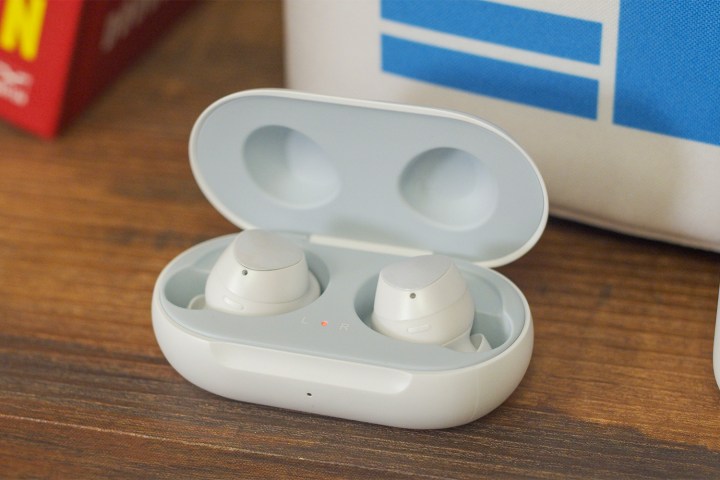
Everyone wants to out-Apple Apple. Proof can be seen everywhere in the tech world, most recently at Samsung’s very Apple-esque Galaxy Unpacked event in San Francisco, set strikingly close to Mobile World Congress. There the company unveiled a slew of new phones, including the thousand-dollar flagship Galaxy S10+ and the company’s first foldable phone known simply as Fold. While few of us may be inclined to buy a $2K tablet that folds down into what looks like a ‘90s sat phone, the innovation is still impressive.
And it didn’t end there. In one of three new wearables revealed at the show, Samsung may soon relax the AirPods’ stranglehold on the true wireless market with the Galaxy Buds, a pair of fully wireless earbuds that are nimble, affordable, feature-packed and — at least at pre-order — bundled with three of the four new phones Samsung introduced. They even charge wirelessly from the back of new Galaxy phones.
But one of the unsung heroes of the show was a feature that’s not new at all. In fact, it’s much older than any of the phones in which it’s featured. That’s right, I’m talking about the headphone jack. Our 3.5mm friend was once rumored to be removed from Samsung’s latest devices, leaving its cellular domain only to LG and a few other holdouts with less cachet. Yet, there it was, slightly off-camera, in all its analog glory.
“A headphone jack?” you ask. “Why would anyone need a headphone jack in this age of wireless wonder?”

It’s a fair point. I mean, just look at those gleaming Galaxy Buds, packing six hours of battery, a tiny, tangle-free footprint, and convenient wireless charging. Who needs to plug in? But before you pull out the pitchforks and the “Down With Luddites” picket signs, allow me to make an appeal for features past.
As a headphone reviewer — and a reluctantly categorized “audiophile” — I use my LG V30’s headphone jack all the time. It even packs a high-end DAC and headphone amplifier, and with a nice pair of headphones (of which I have a few), it sounds glorious. In fact, it’s one of the primary reasons I ditched Apple for Android.
Samsung’s Galaxy Buds may relax the AirPods’ stranglehold on the market.
It’s not just weirdos like me that still back the jack, either. I’d venture to guess there’s probably someone in your life, maybe even someone close to you, who still utilizes this archaic connection. And if it’s not there when you need it, it’s a pain.
“But the iPhone comes with an adapter!” you say.
Forgive my flippant nature but give me a break. Adapters are inconvenient to use, easy to lose, they break, they take up a charging port and, unsurprisingly for their cheapskate design, they don’t sound very good. Who hasn’t chuckled at someone on a flight or at a conference struggling with jackless woes? They dig through their bag to find the dang thing, then string up a smorgasbord of enamel-white wires to connect and charge their phone’s dying battery. It’s funny until it’s you.
Bottom line: A luxury technology product (and a $1,000 phone is a luxury, don’t kid yourself) shouldn’t require you to lug around a cheap piece of plastic for backward compatibility.

Samsung tapped into this recently in a series of brilliant Galaxy commercials that are part of the company’s efforts to elevate its phones above the iPhone — or closer to it than anyone else, anyway. Even Google’s Pixel phone which, of course, followed Apple by dropping the jack, submits to Samsung’s Galaxy as the iPhone for those who’ve dropped the iPhone. That’s why we were so surprised to hear rumors of the jack’s demise ahead of the new Galaxy releases, and so happy to see it sticking around.
When it comes down to it, Samsung gets what Apple doesn’t: The future is great, but people still love their old tech. It’s the reason 4K TVs still play HD and SD broadcasts. It’s why 4K Blu-ray players (may they rest in peace) play regular Blu-rays and even DVDs for that matter. It’s why newer receivers and amplifiers went back to adding phono preamps for the hipster-led vinyl revival. People like old stuff — sometimes because it’s cool and nostalgic, but more often because its prevalent and, dammit, it still works.
Apple has given up everything aging for dead.
Apple has either forgotten this obvious observation, or it just doesn’t care. After all, the company makes a ton of cash on replacements for all those lost and broken plastic adapters. Whether it’s jack-less phones or port-less laptops, Apple seems to have given up everything aging for dead.
At the end of the day, sticking with the headphone jack on the latest Galaxy phones isn’t about holding onto old technology or denying the future, it’s about basic convenience through backward compatibility. It’s about supporting the old ways while ushering in the new ones. It’s the whole having the cake and eating it too situation — and a dozen other platitudes.
How do Samsung and others usurp Apple’s throne? By giving us more with new technology, not less. It’s pretty simple.


